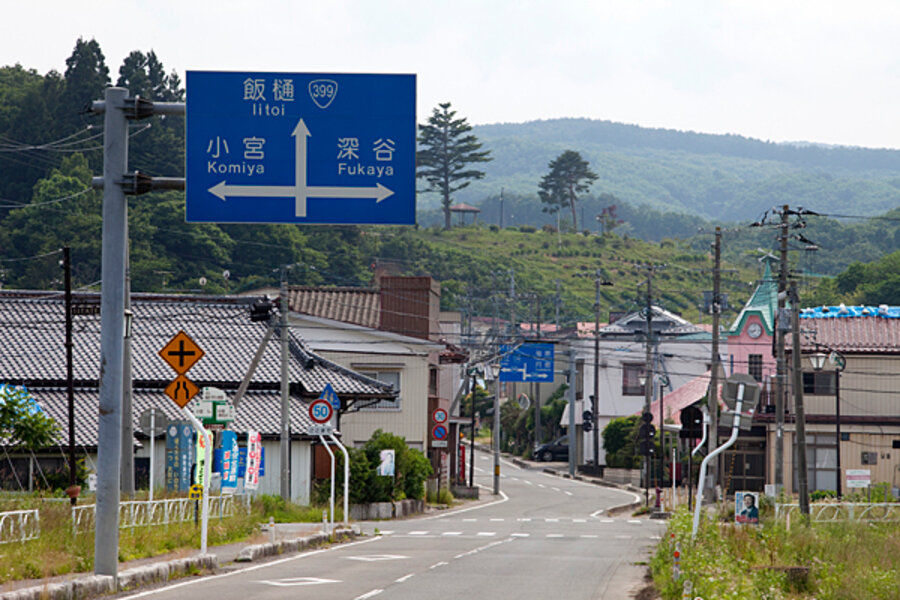Beyond Japan's Fukushima exclusion zone, shuttered shops speak to radiation doubts
Loading...
| Okaba, Japan
Ichiro Monakata sits at a small table in his cramped and dusty village store and swats flies all day. Sometimes, for a change, he goes into a backroom to watch the daytime soaps on his television.
“You can see nobody comes here,” he laughs ruefully. “I’m alone.”
Mr. Monakata is one of the very few people still living in the bucolic countryside just outside the 12.5-mile radius exclusion zone surrounding the crippled Fukushima Daiichi nuclear plant, where three reactors exploded after the March 11 earthquake and subsequent tsunami. But fears of radiation have spread far beyond the hills around this hamlet.
The government says it is safe to live here, but with the invisible threat of radioactivity hanging over the area, hardly anybody wants to.
The dead, brown stalks of last year’s rice harvest poke from untilled paddy fields that at this time of year should be vivid green with a fresh crop. In village after deserted village, shops are shuttered, homes are locked and abandoned, mailboxes are empty.
Monakata says he is untroubled by the potential danger of the radiation that has leaked from the Fukushima plant to hang in the air and contaminate the soil. But few others in Fukushima prefecture are so insouciant.
What about the children?
In the small city of Date, 35 miles from the plant, the anxiety is palpable – especially among parents of young children.
“I’m afraid for my son,” says Kumiko Anzai as she finishes her weekly shopping at a local supermarket. “He’s only 2, so I don’t let him play outside. I keep the windows shut, and I don’t dry my laundry outside.”
The authorities in Date have banned schoolchildren from playing outdoors and obliged them when they are in school to wear long-sleeved shirts and trousers, or tights for girls, to try to reduce their exposure to radiation in the air.
Radiation detectors
In August, says Hiroshi Ono, an official with the local education department, the city will issue individual radiation detectors to all school-age children “to respond to growing worries about radiation exposure.” The much larger city of Fukushima has announced it will do the same for 34,000 pupils when the autumn term begins in September.
“That doesn’t mean my kids will be protected, though,” points out Hitomi Kawaguchi, whose two boys attend school in Date. “And what can I do if I find the [radiation] reading is too high? What will happen if this problem goes on for another five or six years?”
The individual detectors “will be useful only in the distant future, in studies correlating exposure with cancer rates,” argues Hisako Sakiyama, a former head of the National Institute of Radiological Studies. “They cannot prevent exposure.”
After the nuclear accident, the Japanese government set 20 millisieverts (mSv) per year as an acceptable exposure rate for children – the same level as some countries set for nuclear plant workers. Although officials have since said they aim to reduce the ceiling to its previous 1 mSv level, it is unclear how they can do so.
International studies have found that extended 20 mSv-per-year exposure may cause between 20 and 40 instances of cancer per 10,000 people.
Food and soil contamination
Air quality is not the only worry, however. Food grown in soil contaminated by radiation leaks when the reactors exploded, and when engineers vented the reactors to reduce pressure, is another threat.
Safety inspectors have rejected 266 of 2,000 food samples they have tested since March. Inspectors cite dangerously high levels of radiation, according to Ichiro Arakawa, head of environmental safety at Fukushima prefecture’s agriculture department.
His department opened a new food testing center earlier this month, to expand and speed up the inspection process, but the move does not reassure everyone.
“I don’t think the legal ceilings are acceptable,” says Dr. Sakiyama, who points out that in some cases they are 20 times higher than similar standards imposed by the Ukrainian and Belarussian authorities after the Chernobyl disaster. “They were set by the Nuclear Safety Agency, which is a pro-nuclear organization,” Sakiyama complains.
Fukushima officials, however, say they have regained public trust in their agricultural produce by publishing the results of their food inspections every day. Though the prefecture’s agricultural sales in April plummeted by nearly half from those a year earlier, sales were nearly back to normal in May, according to Hideyuki Nikaido, an agriculture department spokesman.
Moto Okubo, a dairy and beef farmer who lives 20 miles from the nuclear plant, is grateful for that. For three months, he was unable to sell any of his milk, even though nobody ever tested it to see whether it was safe. The government imposed a blanket ban on all milk produced within 20 miles of Fukushima Daiichi, so he had to pour it down the drain.
Nor did delivery men dare to drive so close to the plant, which meant that for two months Mr. Okubo received no animal feed. He put his cattle on half rations, but it was not enough: Three of his dairy cows died of starvation.
As he buried them himself, digging their graves with a shovel, “I felt like giving up,” he recalls.
Now that he can sell his milk again after it passed radioactivity tests, he has turned his mind to seeking compensation for his losses during the radiation scare.
“I wrote a letter to Tepco [the nuclear plant operator] setting out our losses and claiming 4.5 million yen [$56,250] from them,” he says. “So far all I’ve had back is a letter from their lawyers apologizing for what happened.”
Tepco is working to resolve the problem of what to do with heavily contaminated water used to cool reactors at Fukushima. Today, its latest attempt at recycling the water was suspended temporarily due to problems with the system.
[ Video is no longer available. ]



